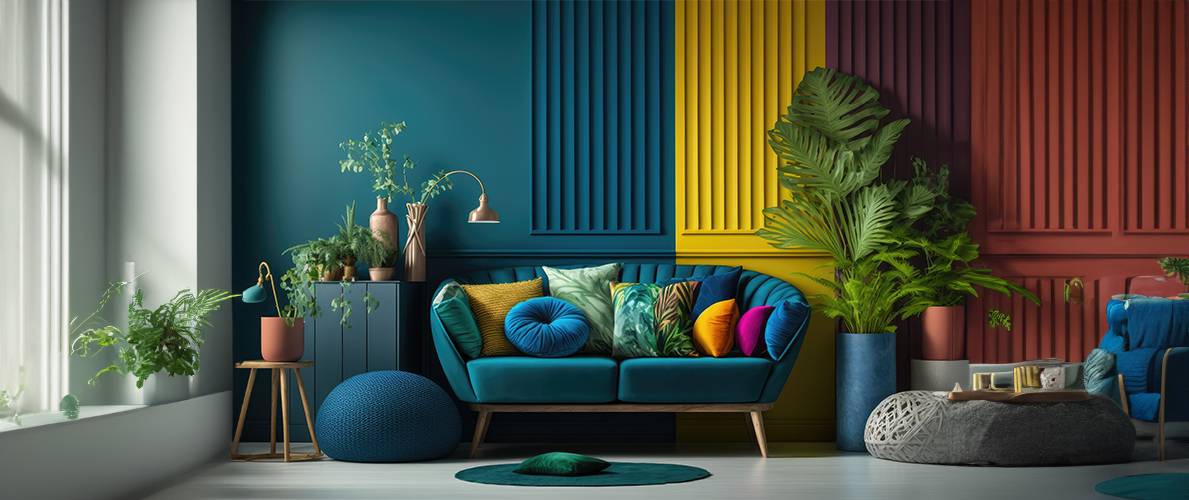Transform Your Home With Vital Principles of Interior Decoration and Visual Appeals
The art of transforming your home via the necessary principles of interior decoration and visual appeal calls for a thoughtful technique that harmonizes shade, equilibrium, and spatial recognition. By understanding the influence of shade theory and the significance of texture and patterns, one can produce spaces that are not just visually attractive yet likewise deeply individual. Accomplishing this equilibrium includes more than mere design; it incorporates a critical arrangement and an eager understanding of how each aspect interacts within an area. As we discover these fundamental concepts, take into consideration how they may redefine your understanding of home and individual expression.
Recognizing Shade Concept
Understanding the principles of shade concept enables developers to create rooms that reverberate mentally with passengers while meeting functional needs. Each group plays a critical function in establishing consistency within an area.
The psychological impact of shades is profound; warm shades such as reds and oranges evoke power and heat, while amazing tones like blues and eco-friendlies advertise calmness and peace. In addition, using complementary colors enhances aesthetic interest, developing striking contrasts that can raise a space's appeal.
Neutral colors, on the various other hand, act as a versatile background, allowing other layout components to radiate. It is important to take into consideration aspects such as illumination and the area's function when picking a color combination, as these can change the perception of colors throughout the day.
Inevitably, a well-considered color plan can change a room, promoting a feeling of convenience and style that lines up with the inhabitants' preferences. Proficiency of shade theory is, consequently, a vital ability for any type of indoor developer intending to create harmonious and inviting atmospheres.
Attaining Balance in Design
Exactly how can designers achieve a feeling of stability in their rooms? Attaining equilibrium in style is essential to developing unified insides.
Unbalanced balance, on the other hand, relies upon varying components that still attain a natural appearance. This method allows for more vibrant and casual setups, giving rate of interest while preserving equilibrium. By thoroughly selecting differing sizes, colors, and structures, developers can create an aesthetically engaging space that feels balanced yet energised.
Radial balance emphasizes a main centerpiece with components radiating outward. This design is frequently seen in circular formats, where furniture and style produce a natural border that attracts the eye internal.
Inevitably, accomplishing equilibrium needs thoughtful factor to consider of scale, percentage, and the connections in between aspects. interior design firms. By masterfully applying these balance concepts, developers can transform rooms into settings that feel both cosmetically pleasing and functionally harmonious, boosting the overall experience for occupants
Relevance of Spatial Awareness

An eager feeling of Full Report spatial recognition allows developers to recognize focal factors within a room, guiding the viewer's focus to essential functions while preserving a general sense of unity. It likewise helps in the tactical placement of illumination, which can dramatically influence the assumption of room and mood. Recognizing spatial partnerships allows the designer to cater to the particular needs of inhabitants, making certain that each location offers its desired function without compromising aesthetics.
Inevitably, spatial understanding is essential for making the most of the potential of any kind of interior room. By very carefully considering the interplay between measurements, layout, and feature, designers can develop settings that not just meet sensible requirements however additionally evoke a feeling of comfort and appeal, enhancing the general living experience.
Incorporating Texture and Patterns
Embracing a diverse series of textures and patterns can dramatically enhance the aesthetic and tactile allure of an interior area. The strategic use various products-- such as wood, metal, material, and internet rock-- creates deepness and rate of interest, making an area feel much more welcoming and vibrant. Combining smooth surface areas with rough structures can develop a balance that draws the eye and engages the detects.
When incorporating patterns, think about both range and rep. Huge patterns can act as centerpieces, while smaller sized, subtle layouts can complement other elements without frustrating the room. Layering patterns, such as pairing floral cushions with striped throws, adds intricacy and a feeling of consistency if executed attentively.
It is also crucial to keep a natural color scheme, making certain that appearances and patterns interact instead of contend get redirected here for attention. By picking a few essential textures and patterns, you can develop a merged aesthetic that mirrors your personal design while boosting the general ambiance of the space. Ultimately, the mindful consolidation of these aspects can change a mundane room into an innovative atmosphere rich with personality and warmth.
Customizing Your Space
Producing a space that reflects your individuality is important to attaining a really welcoming environment. Customization in interior design enables you to instill your distinct design and interests right into your home, transforming it from a simple shelter into a sanctuary that talks to that you are. Begin by selecting a shade scheme that reverberates with your emotions-- strong hues can stimulate, while soft tones offer serenity.
Include art work and decor that show your interests, whether it be traveling, nature, or abstract ideas. Showing individual collections, such as publications, photographs, or souvenirs, can evoke treasured memories and produce focal factors within a room. Additionally, take into consideration personalizing practical items, like upholstered furnishings, to align with your visual preferences.

Final Thought
Finally, the transformation of a home via the essential concepts of interior decoration and aesthetic appeal necessitates a detailed understanding of color concept, balance, spatial recognition, structure, and personalization. Each component contributes dramatically to creating a harmonious and practical living environment - Architecture Firm. By thoughtfully incorporating these principles, people can enhance the aesthetic allure and emotional vibration of their spaces, ultimately cultivating a home that reflects special identifications while supplying convenience and practicality
Comments on “Find an expert Architecture Firm to build your vision.”